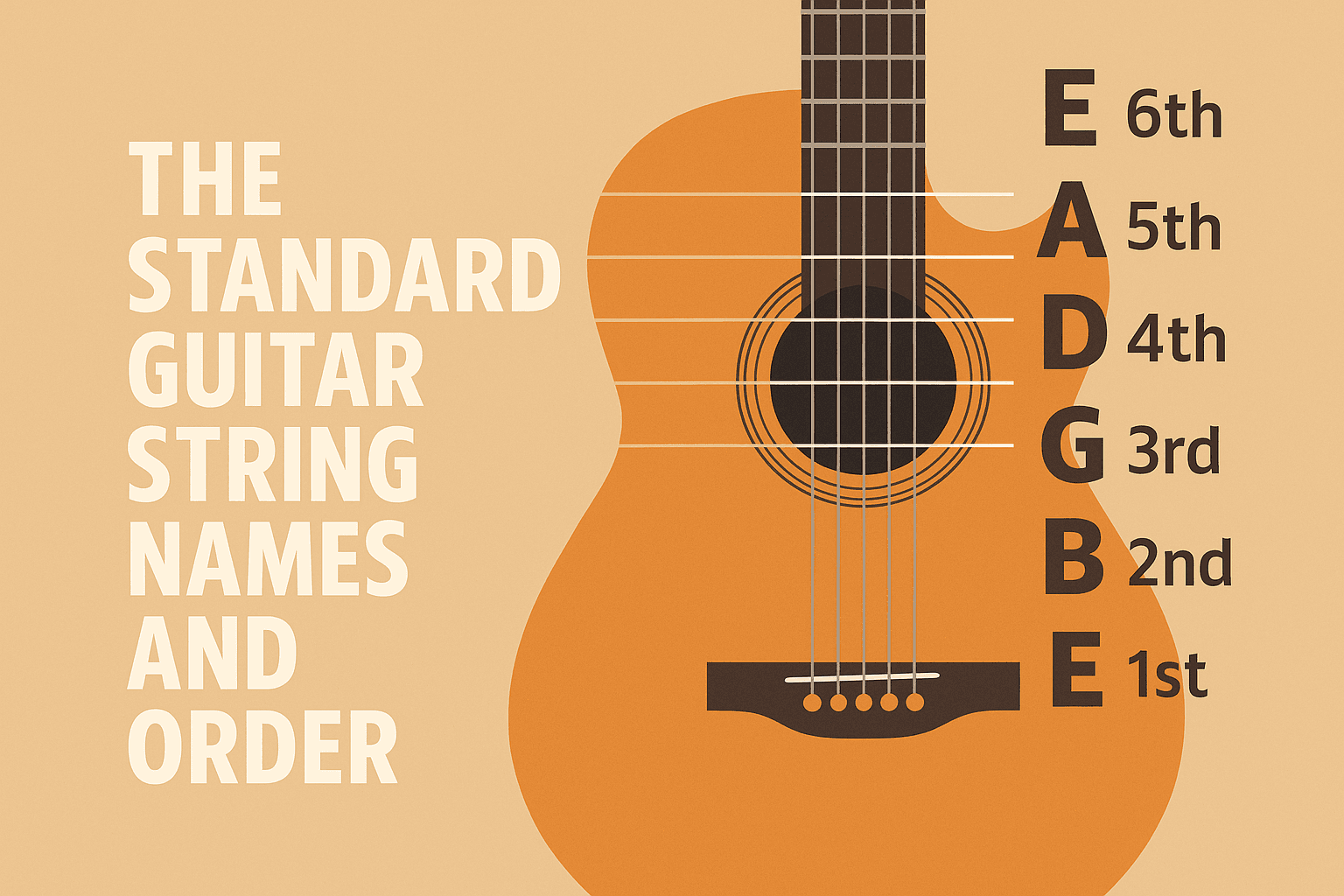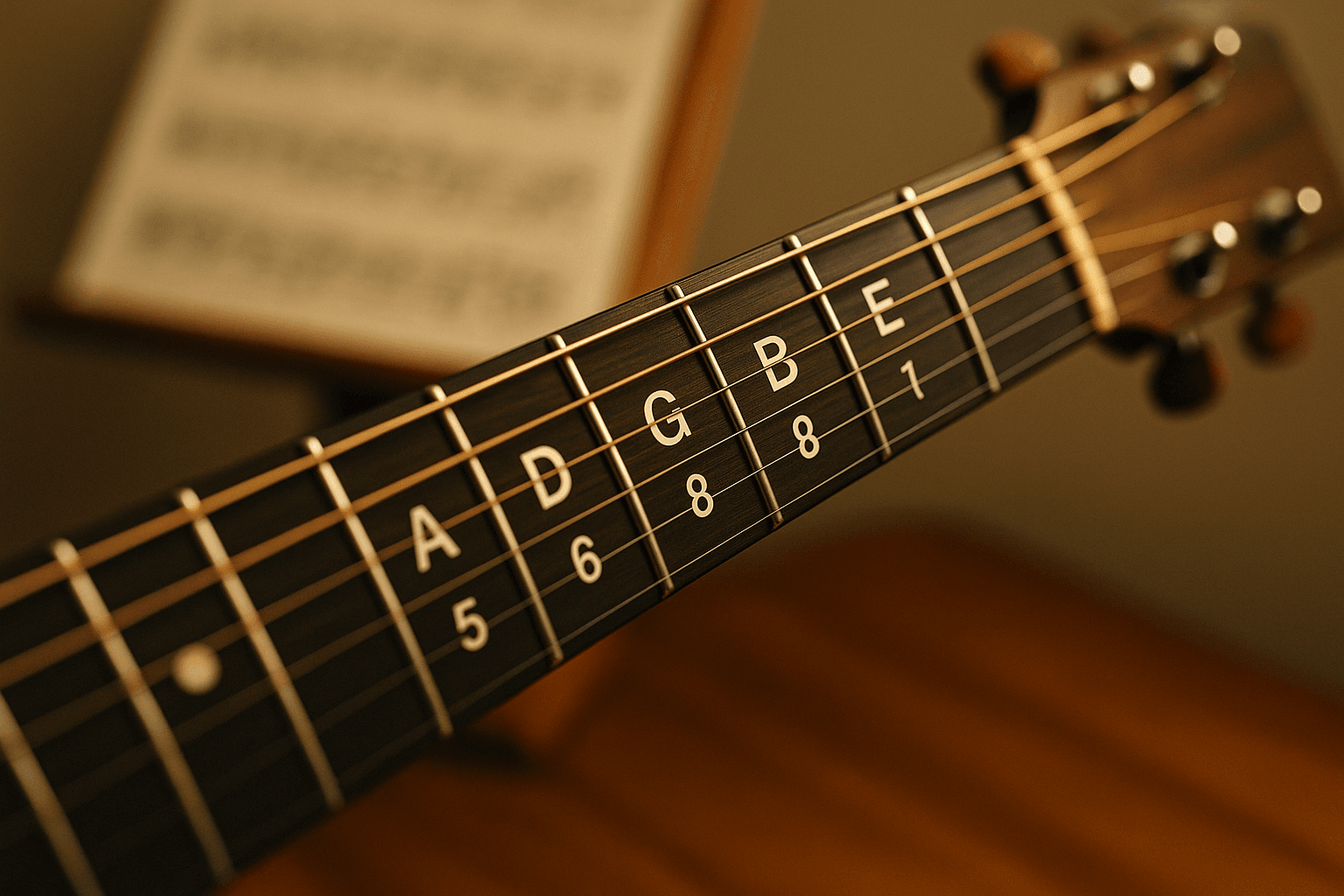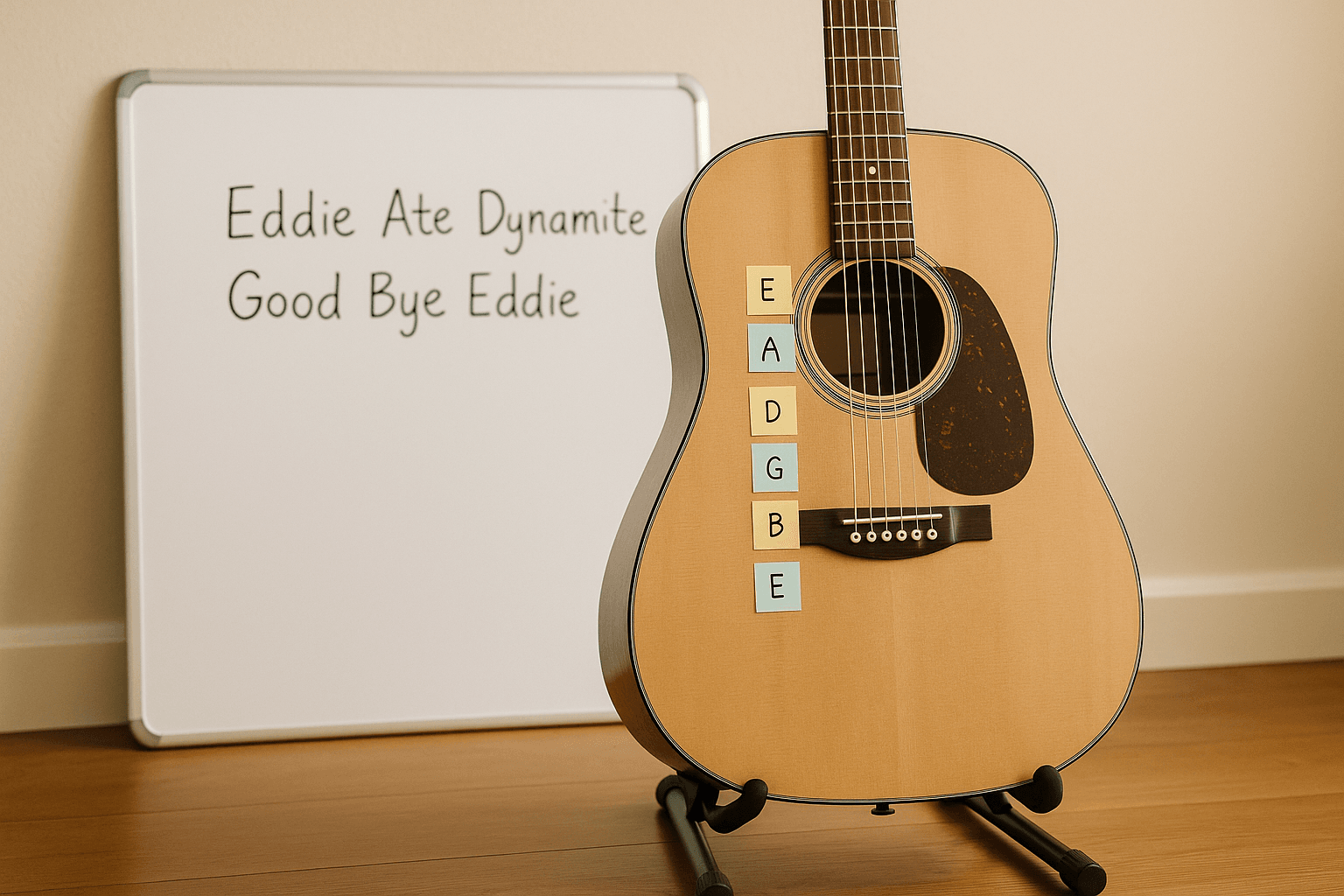
Art Gharana — 12 Mins read
Complete Guitar Strings Guide (Electric & Acoustic)
Musical Instruments
 Have you ever picked up a guitar, strummed a few strings, and wondered what those strings are actually called—or why they’re arranged the way they are? If so, you’re not alone. For many beginners, learning the guitar string notes feels like trying to decode a secret language. But here’s the good news: once you understand the guitar strings order, string names, and the logic behind their letters and numbers, everything starts to make sense—and your musical journey becomes a lot more exciting.
Have you ever picked up a guitar, strummed a few strings, and wondered what those strings are actually called—or why they’re arranged the way they are? If so, you’re not alone. For many beginners, learning the guitar string notes feels like trying to decode a secret language. But here’s the good news: once you understand the guitar strings order, string names, and the logic behind their letters and numbers, everything starts to make sense—and your musical journey becomes a lot more exciting.
Whether you're learning on an acoustic or electric guitar, knowing what each string represents is one of the first—and most important—steps toward playing confidently. Terms like EADGBE, guitar string letters, and guitar string numbers might sound intimidating at first, but they’re easier to remember than you think, especially with the right tools and tricks.
In this beginner-friendly guide, we’ll walk you through everything you need to know—from the guitar strings names in order to fun ways to remember guitar strings using acronyms and mnemonics. By the end of this read, you’ll not only understand the layout of your six-string guitar, but also feel equipped to use that knowledge to play better, faster, and with more confidence.
Ready to break down the mystery of those strings and start playing smarter? Let’s dive right in.
 If you're new to the guitar, one of the first concepts you’ll encounter is the idea of guitar string notes. You might have already heard phrases like guitar string names, guitar string letters, or even six-string guitar notes—but what exactly do these terms mean? More importantly, why should you take the time to understand them?
If you're new to the guitar, one of the first concepts you’ll encounter is the idea of guitar string notes. You might have already heard phrases like guitar string names, guitar string letters, or even six-string guitar notes—but what exactly do these terms mean? More importantly, why should you take the time to understand them?
Let’s simplify the concept so you can build a strong foundation from the very beginning.
Each string on a guitar produces a specific pitch when played open, meaning without pressing down on any fret. This pitch is referred to as the open string note. These notes are consistent across standard-tuned guitars, whether acoustic or electric, and are fundamental to everything from tuning and chord construction to scale practice and music reading.
The standard tuning for a six-string guitar, from the thickest string (closest to you) to the thinnest (farthest away), is as follows:
This tuning is often referred to by the sequence of letters: E-A-D-G-B-E.
It’s worth noting that the first and sixth strings are both tuned to E, but they are two octaves apart. This layout forms the basis of the guitar's standard sound and is something every guitarist should know by heart.
 Many beginners initially focus only on learning chords or simple melodies, overlooking the importance of understanding string notes. However, learning the guitar strings names in order early on can significantly accelerate your overall progress. Here’s why:
Many beginners initially focus only on learning chords or simple melodies, overlooking the importance of understanding string notes. However, learning the guitar strings names in order early on can significantly accelerate your overall progress. Here’s why:
Understanding string notes is not just about memorization—it's about unlocking your ability to play with control, confidence, and creativity.
One common question beginners have is whether acoustic and electric guitars use different string names or orders. The answer is simple: they do not. Both acoustic and electric guitars in standard tuning use the same sequence: E-A-D-G-B-E.
While the tone, feel, and style of playing may vary between the two types of guitars, the foundational structure remains the same. This means that once you’ve learned the standard string notes, you can apply that knowledge to either type of guitar without any adjustments.
If you're looking to build on this knowledge and get guided help from experts, consider exploring Art Gharana’s online guitar classes. These classes are structured to help beginners transition smoothly from basic concepts to full songs and techniques.
While mastering guitar string notes helps you become a better musician, it’s also worth noting that playing the guitar offers additional advantages. Studies and music therapy experts have shown that playing an instrument like the guitar can contribute to better mental clarity, improved concentration, reduced stress, and even better physical coordination. To explore this further, you can read our article on how playing guitar can improve your health.
If you’re ready to put your knowledge into practice, the best way to start is by learning directly from experienced instructors. You can book a free trial class with Art Gharana today and take the first step toward becoming a confident guitar player.
In the next section, we’ll go deeper into how these strings are arranged and named—helping you remember them effortlessly.
 Once you understand what string notes are, the next logical step is to learn the standard guitar string order. This is where many beginners get confused—“Is the first string the one at the top or the bottom?” or “Why do two strings have the same name?” Don't worry. These are common questions, and the answers are surprisingly simple once explained properly.
Once you understand what string notes are, the next logical step is to learn the standard guitar string order. This is where many beginners get confused—“Is the first string the one at the top or the bottom?” or “Why do two strings have the same name?” Don't worry. These are common questions, and the answers are surprisingly simple once explained properly.
Let’s start by clearing up one of the biggest sources of confusion.
Although it may seem like the topmost string (the thickest) should be called the first, in guitar terminology, the first string is actually the thinnest one at the bottom when you're holding the guitar in a playing position. From there, the strings are numbered upward:
This is the guitar strings order used in standard tuning and applies to both acoustic and electric guitars.
Each string on a six-string guitar is assigned a letter name based on its pitch when played open. These names, from the sixth to the first string, are:
This sequence—EADGBE—is what most beginner players are taught from day one. It’s the global standard in guitar tuning, making it easier for you to read tutorials, tabs, chord diagrams, and collaborate with other musicians.
If you're feeling overwhelmed trying to memorize this, don’t worry—we'll cover clever ways to remember these guitar string names in the next section.
When discussing guitar strings, it’s essential to understand the directional language used by musicians.
This can feel counterintuitive at first, especially when visually the top string is physically closer to you. But once you think in terms of pitch—low to high—it all makes sense. The top string (6th) produces the lowest pitch, while the bottom string (1st) produces the highest.
Yes—whether you're playing an acoustic or electric guitar, the guitar strings names in order remain the same: E-A-D-G-B-E. The tone and construction of the guitar may change, but the string layout is standardized for consistency across all types of guitars.
This means that once you learn the standard string order, you can confidently play any six-string guitar without having to relearn the basics.
If you’re looking to build confidence with hands-on instruction and personalized feedback, consider joining Art Gharana’s online guitar classes. They’re designed specifically for beginners and help simplify concepts like string order and finger placement so you learn faster and smarter.
Still unsure if you're getting it right? Don’t hesitate to book a free trial class and get expert help in real time. Sometimes, a little guidance can go a long way when mastering the fundamentals.
Next, we’ll dive into how string letters and numbers work together—and how understanding both can speed up your learning dramatically.
 At this point, you’ve learned what string notes are and how the standard order of strings works on a guitar. Now, it’s time to dig a little deeper—because knowing just the order isn’t enough. To truly understand your instrument and unlock its full potential, you need to be familiar with how guitar strings are labeled by both letter and number. This knowledge will help you read music, follow lessons, and play with greater accuracy.
At this point, you’ve learned what string notes are and how the standard order of strings works on a guitar. Now, it’s time to dig a little deeper—because knowing just the order isn’t enough. To truly understand your instrument and unlock its full potential, you need to be familiar with how guitar strings are labeled by both letter and number. This knowledge will help you read music, follow lessons, and play with greater accuracy.
Each string on a six-string guitar has a specific letter name that corresponds to a musical note. These letters are:
This sequence—EADGBE—is the foundation of standard tuning and appears across nearly all beginner and advanced tutorials. Whether you're reading chord charts, tablature, or sheet music, these string names tell you exactly where to place your fingers and what sound to expect.
Understanding the guitar strings by letter is not just about memorization—it’s about building a deeper connection with your instrument.
In addition to letter names, strings are also numbered to help with orientation and learning. This system is especially useful in lessons, guitar tablature, and online tutorials.
Here’s how the guitar string numbers are assigned:
It’s important to remember that string numbers count from the bottom up when the guitar is held in playing position. Many beginners reverse this at first, thinking the top string is the first—but it’s actually the sixth.
Learning both systems—string letters and string numbers—allows you to interpret any piece of guitar instruction, no matter the format.
You might be wondering whether acoustic guitar string letters are any different from electric guitar strings. The short answer is no.
Both types of guitars use the same tuning and the same guitar string letters in order. What changes between them is the sound output, feel, and playing style—not the foundational layout. That means once you’ve mastered the string names and numbers on one, you can easily transfer your skills to the other.
If you're not sure where to start, Art Gharana’s online guitar classes make it easy to grasp these basics with guided instruction, practice exercises, and live feedback from professional guitarists.
When reading tablature or chord diagrams, you’ll often see both numbers and letters used. For example:
A chord chart might say: “Place your index finger on the 2nd fret of the 5th string (A).”
A tab might look like: A|--2--| E|--0--|
Being able to translate this means you understand that you're pressing the second fret of the A string, which is also the 5th string. This dual system helps improve your ability to read and play music accurately, without second-guessing which string is being referenced.
Feeling unsure about identifying strings by name or number? You’re not alone. Many learners struggle with this in the beginning. That’s why it’s helpful to book a free trial class with a qualified instructor who can walk you through these concepts in a hands-on, practical way.
In the next section, we’ll look at fun and effective ways to remember guitar strings, so you never have to hesitate or second-guess while playing.
Learning guitar string notes may seem overwhelming at first, especially when you're just beginning music lessons. But with the right approach, memorizing string names and their corresponding notes can actually become second nature. So, how do you get there?
Let’s break it down.
Before diving into techniques, ask yourself: Why should I memorize guitar string notes?
Here’s why:
In short, learning guitar string notes is the first step toward playing songs independently and creatively.
First, you need to know the names of the six guitar strings in order. From the thickest (top when holding the guitar) to the thinnest (bottom), the standard tuning is:
A popular mnemonic to remember this order is:
Eddie Ate Dynamite Good Bye Eddie
It’s quirky, but it works!
Let’s look at a few proven strategies to make the string names and notes stick.
1. Repetition with Purpose
2. Use Flashcards or a Music Practice App
3. Label Your Strings Temporarily
4. Apply Notes in Context
Want to remember faster? Learn the intro to a song you love that starts on a certain string. Associating real sound with theoretical notes bridges the gap between knowledge and practical playing.
Final Thought
Memorizing string names isn’t just about rote learning—it’s about building a musical mindset. If you're still wondering how to learn music or how to study music at home, mastering string notes is a smart place to begin. It sets the stage for everything from understanding guitar string numbers to exploring chord progressions.
Take it one string at a time—literally—and you’ll be well on your way to becoming confident with the guitar!
 Memorizing guitar string notes might feel overwhelming at first, especially if you’re just beginning your musical journey. But don’t worry — it’s not as complex as it seems. With the right techniques, you’ll soon find yourself recalling each note with confidence. So, how do you make guitar string names second nature? Let’s break it down with some practical and engaging tips.
Memorizing guitar string notes might feel overwhelming at first, especially if you’re just beginning your musical journey. But don’t worry — it’s not as complex as it seems. With the right techniques, you’ll soon find yourself recalling each note with confidence. So, how do you make guitar string names second nature? Let’s break it down with some practical and engaging tips.
1. Use a Catchy Mnemonic One of the simplest ways to remember the standard tuning of guitar strings — E-A-D-G-B-E — is by using a mnemonic. This method links each note to a word in a sentence, making it easier to recall. Here are a few popular examples:
Feel free to come up with your own — the more personal and quirky, the better!
2. Repeat, Repeat, Repeat
Repetition is your best friend when it comes to memory. Start your practice by reciting the string names aloud, both forwards and backwards. You can even quiz yourself by pointing to a string and trying to recall its name.
3. Label Your Guitar (Temporarily)
If you’re a visual learner, label the strings with stickers or small tags showing their note names. Every time you look at your guitar, you'll reinforce your memory. Just be sure to remove them once you're confident to avoid dependence.
4. Incorporate Notes into Your Practice Routine
Don't wait until you’ve “memorized everything” — start applying your knowledge while you play. For example:
5. Use a Music Practice App
If you're into tech, there are several music practice apps and guitar learning platforms designed to help with note recognition and finger placement. These interactive tools make learning fun and adaptive.
6. Turn It Into a Game
Challenge yourself with flashcards or have a friend test you randomly. The key is to make learning interactive and enjoyable, so it doesn’t feel like a chore.
Final Thoughts
Building muscle memory and note recognition takes time, but with consistent effort, it becomes second nature. Whether you're learning guitar at home or exploring music lessons for adults beginners, mastering the basics like string notes is the stepping stone to becoming a confident guitarist.
By the way, if you’re wondering how to take your learning further, explore Art Gharana’s Online Guitar Classes — ideal for beginners who want to build a solid foundation in a structured yet creative environment. You can even book a free trial class to get started.
Learning the guitar isn’t just about playing chords or strumming strings—it’s about expressing yourself, embracing creativity, and nurturing a lifelong passion. Whether you're seeking a new hobby, looking to improve your focus, or dreaming of performing on stage, the guitar can open up a world of possibilities.
So, ask yourself—what’s stopping you from starting now?
With online guitar classes from Art Gharana, you don’t need to commute or adjust your busy schedule. You can learn music right from the comfort of your home, guided by experienced mentors who are as passionate about teaching as they are about music. You’ll learn not just how to play, but how to love playing.
No matter your age or skill level, the guitar welcomes you with open frets. And the best part? You're not alone on this journey. A supportive learning environment, structured lessons, and personalized attention await you.
Curious to see how it works? Book a free trial class today and take the first step toward mastering this versatile instrument.
After all, every expert was once a beginner—could today be your Day 1?